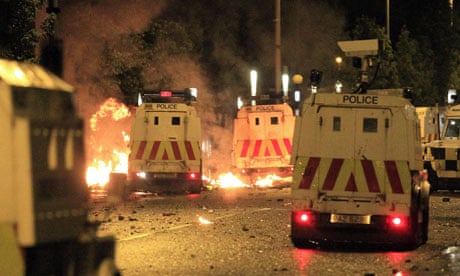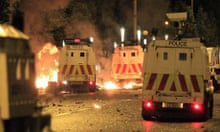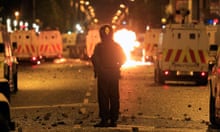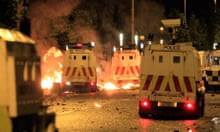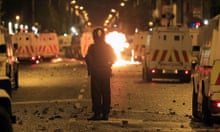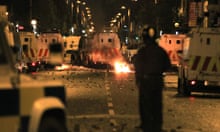A couple of weeks ago I noticed that an Ulster Volunteer Force mural at the bottom of the Ravenhill Road in east Belfast, close to the scene of the recent loyalist attacks, was undergoing a facelift. There was scaffolding in place, and the original wall painting – a couple of masked, gun-toting paramilitaries depicted with disproportionately small legs and feet, which gave the mural a curiously jaunty, leprechaun-style effect – had been chipped away.
Following the new trend in Northern Ireland for replacing hateful, violent imagery with something a little more fragrant (it's called "reimagining communities" in post-conflict corporate speak) I thought we were maybe going to get a picture of kites, balloons and children hugging each other. Some hope. The new mural is painted in grim shades of grey and black, and shows a masked UVF man staring out against a bleak, post-apocalyptic backdrop. The only upbeat thing you can say about it is that the perspective is better.
The reimagined mural (now with heightened aggression) is telling because it shows that the skirmishes just down the road are not random or arbitrary outbreaks of inexplicable violence, as they may appear to outside observers, but the product of an increasingly visible loyalist rage. The appearance of tame-looking loyalist elder statesmen during Queen Elizabeth's recent visit to the Republic gives no sense of the reality on the streets of inner east Belfast, where attacking their Catholic neighbours is a way for blood-hungry young loyalists to gain status and rank in the notoriously volatile command structure of paramilitary organisations.
Throughout the peace process that undercurrent of murderous anger and lawless entitlement has never entirely gone away, causing serious problems for those who sought to usher loyalist paramilitaries down the democratic route. Last year, when members of the UVF shot dead Bobby Moffett, a former loyalist prisoner, in broad daylight on the Shankill Road, it was the last straw for Dawn Purvis, the smart and capable former leader of the Progressive Unionist party (the PUP is a small political grouping linked to the UVF). Tired of doing politics with one hand tied behind her back, she pronounced the UVF to be "more trouble than they are worth" and walked away from the leadership and the party.
Now Purvis, who stood as an independent but lost her seat in the recent assembly elections, is no longer in the invidious position of the having to make excuses for loyalist violence. That thankless task is left to the likes of Jim Wilson of the PUP, who claims that loyalists feel they have been "pushed outside the process" and attributes the recent attacks to a pervading sense of community isolation.
It's true that there is a palpable sense of discontent in loyalist communities, a kind of resentful longing for the old days of pride and primacy. Opportunities are limited in these areas and educational prospects are poor, especially among boys. It's not surprising, then, that the A-word – alienation – has, as usual, been wheeled out as an excuse.
Yet that's rather too glib. It implies that mounting orchestrated and unprovoked attacks on Catholic neighbourhoods is in some way an inevitable outworking of loyalist victimhood – an argument that conveniently allows the perpetrators off the hook.
Lobbing lit fireworks, missiles and petrol bombs is a poor and deeply inarticulate way of expressing grievance and disillusionment, only serving to marginalise these communities still further. But that won't stop the violence. No doubt the buzz of army helicopters will sound again in the skies over Belfast tonight, as loyalists continue to score this series of bloody own goals.
